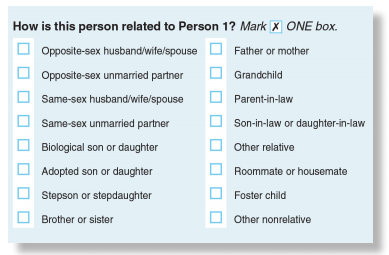Same-sex Households and the 2020 Census
Fact. The U.S. Census Bureau does not ask individuals about their sexual orientation or gender identity.
A significant change from the 2010 Census however, is that for the first time in American history, married same-sex couples will be asked to identify themselves on the decennial census. Following the historic Obergefell v. Hodges case in 2015, which legalized same-sex marriage throughout the United States, the U.S. Census Bureau modified the American Community Survey (ACS) form (below) to count same-sex married households.
Source: U.S. Census Bureau, Questions Planned for the 2020 Census and American Community Survey, March 2018
Prior to this landmark decision, in 2000 the Bush administration ordered the Bureau to officially reclassify individuals identifying as married same-sex couples as “unmarried partners”, citing the Defense of Marriage Act (DOMA). In 2010, the Obama administration reversed the earlier decision and allowed the Bureau to report self-identifying same-sex couples as married.
Accurately reporting the number of same-sex unmarried partners and spouses has been difficult. Upon evaluating responses to separate questions about respondent’s sex and their relationship to the head of household (e.g. spouse or unmarried partner), the Bureau discovered an error. Some opposite-sex couples were inadvertently checking the same sex as their spouse, meaning they were counted them a same-sex couple. To address this issue, the Bureau has modified the household relationship to count opposite and same-sex relationships separately. More information about this issue is available in this report from the Pew Research Center.
There is a unavoidable truth in American democracy, which is that you don’t count unless you’re counted. Recognizing this situation, many LGBTQ civil rights groups have advocated that the U.S. Census Bureau ask respondents about sexual orientation and gender identity. As the first decennial census to ask respondents about same-sex marriages, Census 2020 represents progress towards increasing visibility and addressing inequity for some in the LGBTQ community. As a self-identifying gay man who is married, I too celebrate this important step forward. However, it’s important to remember that these data will enumerate some, but not all gay and lesbian spouses, and by no means will be representative of the larger LGBTQ community.
Read more about same-sex marriages on the upcoming census here.
Source: U.S. Census Bureau, Questions Planned for the 2020 Census and American Community Survey, March 2018
